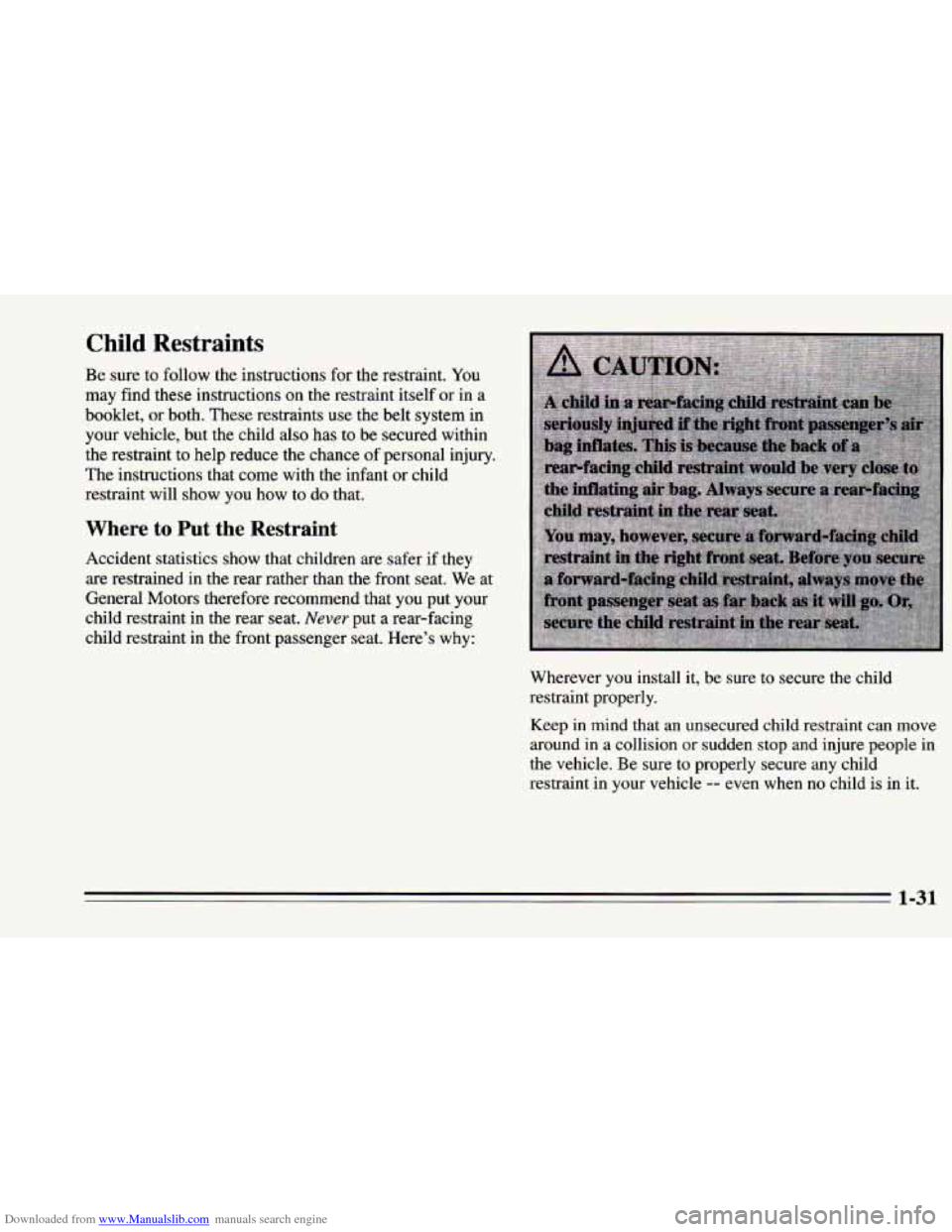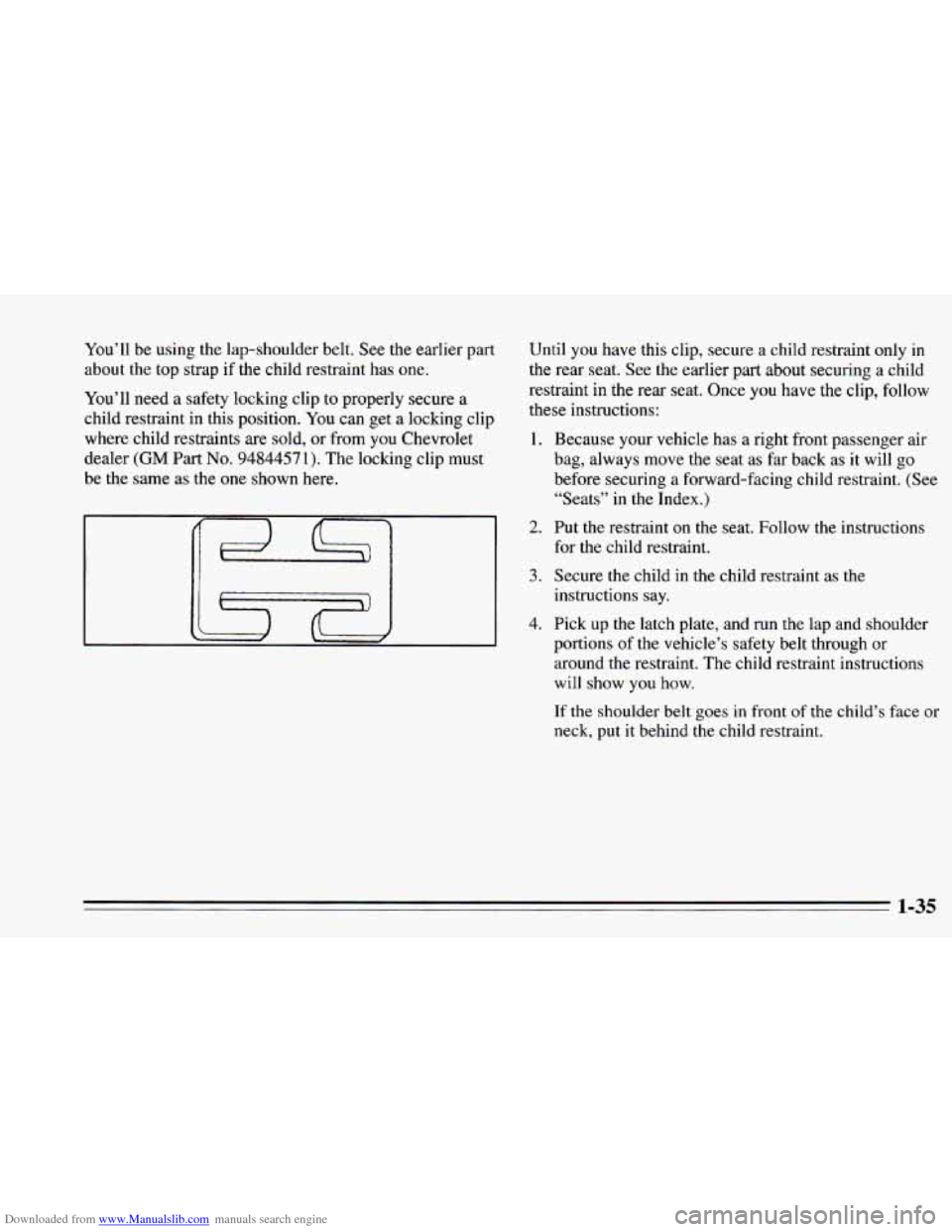Page 23 of 388
Downloaded from www.Manualslib.com manuals search engine Pull up on the latch plate to make sure it is secure. If
the belt isn’t long enough, see “Safety Belt
Extender”
at the end of this section.
Make sure the release button
on the buckle is
positioned
so you would be able to unbuckle the
safety belt quickly
if you ever had to.
5. To make the lap part tight, pull down on the buckle
end
of the belt as you pull up on the shoulder belt. The lap
part of
the belt should be worn low and snug on
the hips, just touching the thighs. In a crash, this applies
force to the strong pelvic bones. And you’d be less likely \
to slide under the lap belt.
If you slid under it, the belt
would apply force at your abdomen.
This could cause
serious or even fatal injuries. The shoulder belt should go
over the shoulder and across the chest. These parts of the
body are best able to take belt reseaining forces.
-.
1-13
Page 36 of 388
Downloaded from www.Manualslib.com manuals search engine .” ..
1. Pick up the latch plate and pull the belt across you.
Don’t let it get twisted.
On convertible models, the shoulder belt may lock if
you pull the belt across
you very quickly. If this
happens, let the belt go back slightly to unlock it.
Then pull the belt across you more slowly.
2. Push the latch plate into the buckle until it clicks. If
the belt stops before it reaches the buckle, tilt the
latch plate and keep pulling until you can buckle it.
Pull
up on the latch plate to make sure it is secure.
If the belt is not long enough, see “Safety Belt
Extender” at the end
of this section. Make sure the
release button
on the buckle is positioned so you
would be
able to unbuckle the safety belt quickly if
you ever had to.
1-26
Page 41 of 388

Downloaded from www.Manualslib.com manuals search engine Child Restraints
Be sure to follow the instructions for the restraint. You
may find these instructions on
the restraint itself or in a
booklet,
or both. These restraints use the belt system in
your vehicle, but the child also has to be secured within
the restraint to help reduce the chance of personal injury.
The instructions that come with the infant or child
restraint will show you how to do that.
Where to Put the Restraint
Accident statistics show that children are safer if they
are restrained
in the rear rather than the front seat. We at
General Motors therefore recommend that you put your
child restraint in the rear seat.
Never put a rear-facing
child restraint
in the front passenger seat. Here’s why:
Wherever you install it, be sure to secure the child
restraint properly.
Keep
in mind that an unsecured child restraint can move
around
in a collision or sudden stop and injure people in
the vehicle.
Be sure to properly secure any child
restraint in your vehicle
-- even when no child is in it.
1-31
Page 43 of 388
Downloaded from www.Manualslib.com manuals search engine Securing a Child Restraint in a Rear Seat
Position
You’ll be using the lap-shoulder belt. See the earlier part
about the top strap if the child restraint has one.
1. Put the restraint on the seat. Follow the instructions
for the child restraint.
2. Secure the child in the child restraint as the
instructions
say.
3. Pick up the latch plate, and run the lap and shoulder
portions of the vehicle’s safety belt through
or
around the restraint. The child restraint instructions
will show
you how. Tilt the latch plate to adjust the
belt if needed.
If the shoulder belt goes in front of the child’s face
or
neck, put it behind the child restraint.
.,. .
4. Buckle the belt. Make sure the release button is
positioned
so you would be able to unbuckle the
safety belt quickly if you ever had to.
1-33
Page 44 of 388
Downloaded from www.Manualslib.com manuals search engine I
5. To tighten the belt, pull up on the shoulder belt while
6. Push and pull the child restraint in different
you push
down on the child restraint.
directions
to be sure it is secure.
To remove the child restraint, just unbuckle the vehicle’s
safety belt and let it
go back all the way. The safety belt
will move freely again and be ready to work for an adult
or larger child passenger.
Securing a Child Restraint in the Right
Front Seat Position
Your vehicle has a right front passenger air bag. Never
put a rear-facing child restraint in this seat. Here’s why:
Page 45 of 388

Downloaded from www.Manualslib.com manuals search engine You’ll be using the lap-shoulder belt. See the earlier part
about
the top strap if the child restraint has one.
You’ll need a safety locking clip to properly secure a
child restraint in this position. You can get a locking clip
where child restraints are sold, or from
you Chevrolet
dealer
(GM Part No. 94844571). The locking clip must
be the same as the one shown here. Until
you have this clip, secure
a child restraint only in
the rear seat. See the earlier
part about securing a child
restraint in
the rear seat. Once you have the clip, follow
these instructions:
1.
2.
3.
4.
Because your vehicle has a right front passenger air
bag, always move the seat
as far back as it will go
before securing a forward-facing child restraint. (See
“Seats” in the Index.)
Put the restraint on the seat. Follow the instructions
for the child restraint.
Secure the child in the child restraint as the
instructions say.
Pick up the latch plate, and run the lap and shoulder
portions
of the vehicle’s safety belt through or
around the restraint. The child restraint instructions
will show
you how.
If
the shoulder belt goes in front of the child’s face or
neck, put it behind the child restraint.
1-35
Page 64 of 388
Downloaded from www.Manualslib.com manuals search engine Parking at Night
Park in a lighted spot, close all windows and lock your
vehicle. Remember to keep your valuables
out of sight.
Put
them in a storage area, or take them with you.
Parking Lots
If you park in a lot where someone will be watching
your vehicle, it’s best to lock it up and take your keys. \
But what if you
have to leave your ignition key? What if
you have to leave something valuable in your vehicle?
Put your valuables in a storage area, like your trunk
or glove box.
0 Lock the glove box.
0 Lock all the doors except the driver’s.
0 Then take the door key with you.
. ‘i
PASS-Key@II
Your vehicle is equipped with the PASS-Key%
(Personalized Automotive Security System)
theft-deterrent system. PASS-Key I1
is a passive
theft-deterrent system. It works when you insert or
remove the key from
the ignition. PASS-Key I1 uses a
resistor pellet
in the ignition key that matches a decoder
in your vehicle.
2-12
Page 65 of 388

Downloaded from www.Manualslib.com manuals search engine When the PASS-Key@II system senses that someone is using the wrong key, it shuts down the vehicle’s starter
and fuel systems. For about three minutes, the starter
won’t work and fuel won’t
go to the engine. If someone
tries to start your vehicle again or uses another key
during this time, the vehicle will not start. This
discourages someone from randomly trying different
keys with different resistor pellets in an attempt to make
a match.
The ignition key must be clean and dry before it’s
inserted in the ignition or the engine may not start. If the
engine does not start and the SECURITY light stays on
when you try to start the vehicle, the key may be dirty or
wet. Turn the ignition
off.
Clean and dry the key. Wait about three minutes and try
again. The security light will remain on during this time.
If the starter still won’t work, and the key appears to be
clean and
dry, wait about three minutes and try another
ignition key.
At this time, you may also want to check
the fuses (see “Fuses and Circuit Breakers” in the
Index).
If the starter won’t work with the other key, your vehicle
needs service.
If your vehicle does start, the first
ignition key may be faulty. See your Chevrolet dealer or
a locksmith who can service the PASS-Key’II.
If you accidentally use
a key that has a damaged or
missing resistor pellet, the starter won’t work and the
security light will flash. But you don’t have to wait three
minutes before trying another ignition key.
See your Chevrolet dealer or a locksmith who can
service the PASS-Key’II to have a new key made.
If you’re ever driving
and the “SECURITY” light comes
on and stays on, you will be able to restart your engine if
you turn it
off. Your PASS-Key@II system, however, is
not working properly and must be serviced by your
Chevrolet dealer. Your vehicle
is not protected by the
PASS-Key@II system.
If you lose or damage a PASS-Key’II ignition key, see
your Chevrolet dealer or a locksmith who can service
PASS-Key’II
to have a new key made. In an
emergency, call the Chevrolet Roadside Assistance
Program at 1-800-CHEV-USA
(1-800-243-8872).
2-13